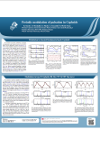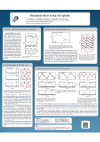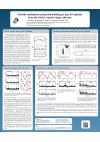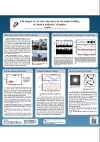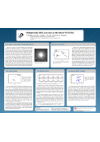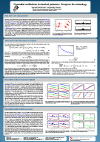Classical pulsators through diverse stellar systems: contrast between pulsation modes
| project | OPUS, DEC-2015/17/B/ST9/03421 |
| funding | Polish National Science Center, NCN |
| PI | Radosław Smolec |
| Co-Is | Paweł Moskalik |
| Igor Soszyński | |
| Wojciech Dziembowski | |
| Andrzej Udalski | |
| Henryka Netzel | |
| Krzysztof Kotysz | |
| Oliwia Ziółkowska | |
| Magdalena Styczeń | |
| dates | 02.2016 - 02.2020 |
Jump to project highlights, refereed publications, conference contributions, and presentations.
Project Highlights
- Census of non-radial pulsation in RRc stars
We have analysed the OGLE photometry for more than 11000 RRc stars located in the Galactic bulge, searching for additional low amplitude periodicities. These were indeed detected in more than 1000 stars and may be divided into two categories. In the first, we observe additional periodicity of shorter period and period ratios Px/P1O in the 0.60-0.64 range. This form of pulsation may be common in RRc stars as space observations and our previous studies (Netzel et al. 2015) reveal. In the analysed sample we have detected 960 such stars and studied their properties in detail. The results support a model proposed by Dziembowski (2016) in which additional periodicities are harmonics of the non-radial modes of moderate degrees. In the second group, additional periodicity is of longer period, even longer than the expected period of the radial fundamental mode; period ratios, P1O/Px tightly cluster around 0.686. Additional variability is always coherent and its origin remains a mystery. Altogether 147 stars of this type were detected and analysed.
More information: Netzel & Smolec, The census of non-radial pulsation in first-overtone RR Lyrae stars of the OGLE Galactic bulge collection, Monthly Notices of the Royal Astronomical Society (2019).
doi:10.1093/mnras/stz1626, arXiv:1908.07251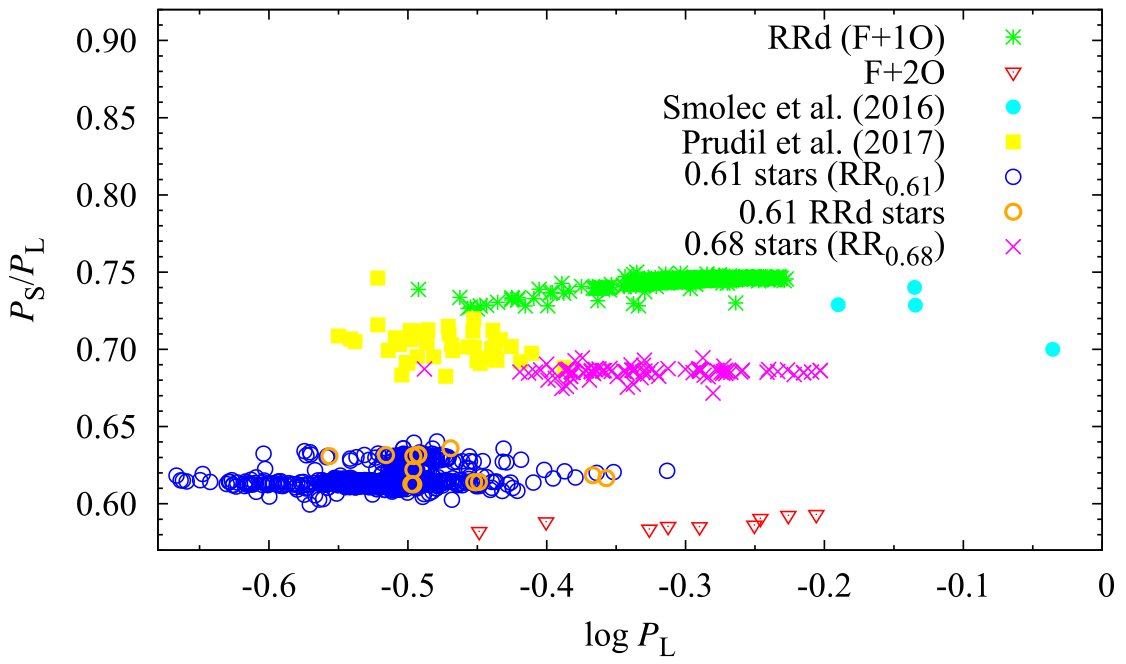
The Figure shows Petersen diagram for RR Lyrae stars with double-periodic stars of the two discussed classes marked with blue and magenta symbols.
- First 1O BL Her stars discovered
Till recently, all type II Cepheids were identified as fundamental mode pulsators. No double-mode or single-mode first overtone type II Cepheids were known. The discovery of the first double-mode radial BL Her stars (Smolec et al., 2018) motivated the search for single-mode first overtone BL Her stars. Two candidates were identified in the LMC based on the location of the stars in the period-luminosity and color-magnitude planes, and on the analysis of their light curve shape. The 1O identification was supported with non-linear pulsation modelling. We were able to reproduce the light curve shapes satisfactorily with first overtone models. Admittedly, the luminosity of the models is too high as compared with observations.
Why double-mode and single mode first overtone pulsation is so rare among type II Cepheids, while it is so frequent in classical Cepheids and RR Lyrae stars? Comparison with RR Lyrae stars, which are the low-luminosity siblings of type-II Cepheids, reveals the answer. While at the level of linear pulsation theory, both fundamental and first overtone modes are linearly unstable over the significant part of the BL Her domain, the non-linear effects favour fundamental mode pulsation. Long-period double-mode RR Lyrae strars are as rare as double-mode BL Her stars.
More information: Soszyński, I., Smolec, R., Udalski, A., Pietrukowicz, P., Type II Cepheids Pulsating in the First Overtone from the OGLE Survey., ApJ (2019).
doi:10.3847/1538-4357/ab04ab, arXiv:1902.02352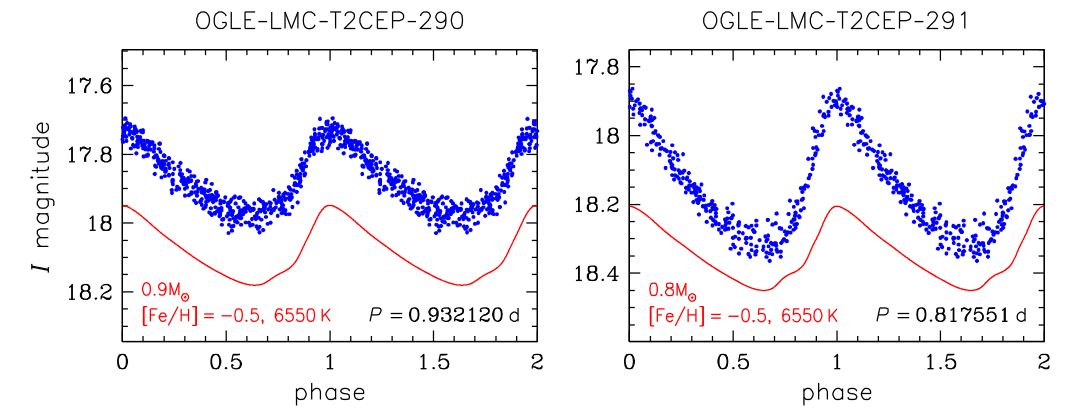
The Figure shows light curves for the two first overtone BL Her stars in the LMC along with the best matching non-linear pulsation models.
- Dynamical phenomena in type II Cepheids
Type II Cepheids are relatively poorly studied. The release of top-quality OGLE data for nearly thousand of these variables located in the Galactic bulge allowed us to study their dynamical properties in detail. Many interesting dynamical phenomena were detected. New cases of period doubled BL Her stars were reported; still the number of known such stars, three, is much lower than one would expect from theoretical predictions. Amplitude of alternations are also very low; in some cases these are possible to detect only thanks to the Fourier analysis. Period doubling is a characteristic feature of RV Tau variables, with periods longer than 20d. However the effect does not switch on abruptly. We have detected period doubling effect in several W Vir stars, starting with pulsation periods as low as 15d and we have shown that the appearance of the period doubling effect is a smooth process. One candidate star for period-4 pulsation was identified.
Another phenomenon that was detected in all groups of type II Cepheids is periodic modulation of pulsation. These are the first modulated type II Cepheids reported in the literature. The effect is particularly interesting in RV Tau stars, in which modulation period is always close to 4 times the pulsation period.
One of the most interesting and fruitful discoveries is the detection of the first double-mode BL Her type stars pulsating simultaneously in the radial fundamental and first overtone modes. The discovery motivated the search for single mode 1O pulsation in type II Cepheids, which is described as other highlight on this page.
More information: Smolec, R., Moskalik, P., Plachy, E., Soszyński, I. & Udalski, A., Diversity of dynamical phenomena in type II Cepheids of the OGLE collection., Monthly Notices of the Royal Astronomical Society (2018).
doi:10.1093/mnras/sty2452, arXiv:1809.02842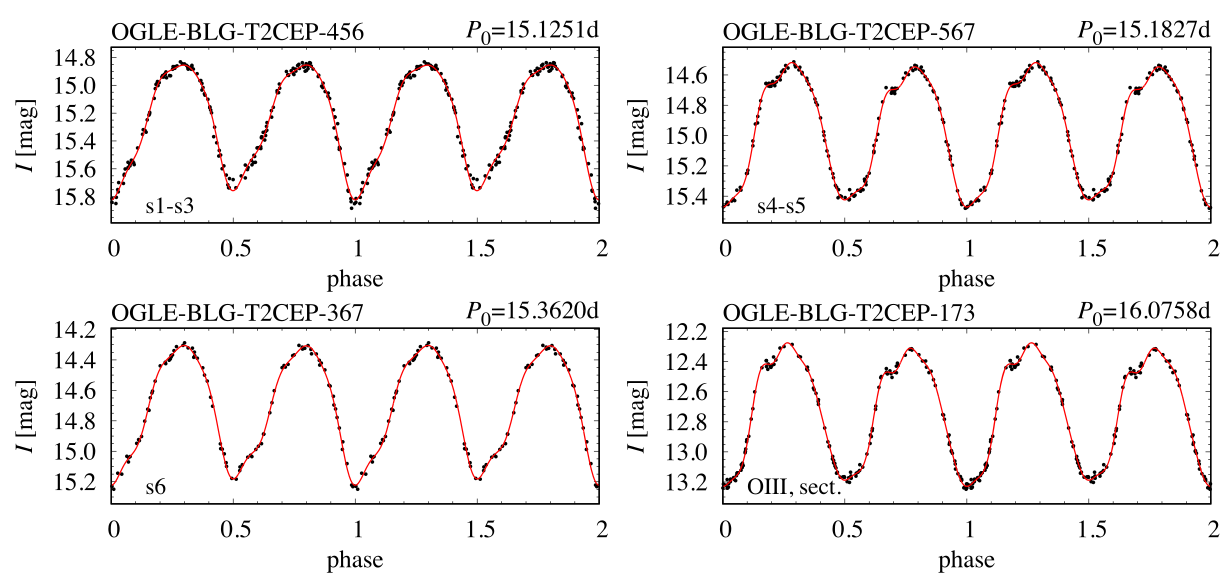
The Figure shows period doubling alternations in four W Vir stars with periods close to 15d.
- Unstable Standard Candles
Classical Cepheids are among the most important variable stars. As primary distance indicators, they are of key importance for stellar astrophysics, galactic astrophysics and cosmology. Stars pulsating in the fundamental mode, thanks to the characteristic light curve shape, and high intrinsic brightness are are among the most useful standard candles. They are believed to be regular pulsators.
Study of the-top quality photometry of the fundamental mode Cepheids from the Magellanic Clouds, collected by the Optical Gravitational Lensing Experiment, reveals that their pulsation is not so simple. In 51 fundamental mode Cepheids periodic modulation of the light curves was detected. Although the overall incidence rate is very low, about 1 per cent in each of the Magellanic Clouds, in the case of the SMC and pulsation periods between 12 and 16 d the incidence rate is nearly 40 per cent. On the other hand, in the LMC the highest incidence rate is 5 per cent for pulsation periods between 8 and 14 d, and the overall amplitude of the effect is smaller. It indicates that the phenomenon is metallicity dependent. Typical modulation periods are between 70 and 300 d. In nearly all stars the mean brightness is modulated, which, in principle, may influence the use of classical Cepheids for distance determination. Fortunately, the modulation of mean brightness does not exceed 0.01 mag in all but one star. Also, the effect averages out in typical observations spanning a long time base. Hence, in studies of sizeable samples of Cepheids with good phase coverage of the light curves, modulation has no practical effect on the distance determinations. It is clear however, that our understanding of the most important astrophysical candles is far from being complete.
More information: R. Smolec, Unstable standard candles. Periodic light curve modulation in fundamental mode classical Cepheids., Monthly Notices of the Royal Astronomical Society (2017).
doi:10.1093/mnras/stx679, arXiv:1703.05358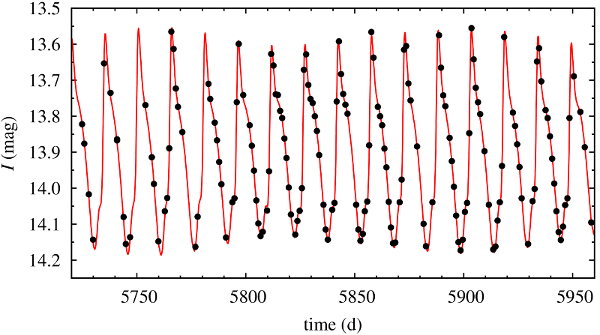
The Figure shows a section of the observations of the modulated Cepheid, OGLE-SMC-CEP-1065 (dots) plotted along with the model (solid red line). Modulation of the light curve is clearly visible.
Refereed Publications
- Prudil, Z., Dekany, I., Smolec, R., Catelan, M., Grebel, E.K., Kunder, A.; Humps and bumps: the effects of shocks on the optical light curves of fundamental-mode RR Lyrae stars; A&A, 635, A66 (2020); ADS, PDF, arXiv:2001.08272
- Netzel, H., Smolec, R.; The census of non-radial pulsation in first-overtone RR Lyrae stars of the OGLE Galactic bulge collection; MNRAS, 487, 5584 (2019); ADS, PDF, arXiv:1908.07251
- Prudil, Z., Dekany, I., Grebel, E.K., Catelan, M., Skarka, M., Smolec, R.; On the Oosterhoff dichotomy in the Galactic bulge: II. kinematical distribution; MNRAS, 487, 3270 (2019); ADS, PDF, arXiv:1905.11870
- Soszyński, I., Smolec, R., Udalski, A., Pietrukowicz, P.; Type II Cepheids Pulsating in the First Overtone from the OGLE Survey; ApJ, 873, 43 (2019); ADS, PDF, arXiv:1902.02352
- Prudil, Z., Dekany, I., Catelan, M., Smolec, R., Grebel, E.K., Skarka, M.; On the Oosterhoff dichotomy in the Galactic bulge: I. spatial distribution; MNRAS, 484, 4833 (2019); ADS, PDF, arXiv:1901.09726
- Smolec, R., Moskalik, P., Plachy, E., Soszyński, I., Udalski, A.; Diversity of dynamical phenomena in type II Cepheids of the OGLE collection; MNRAS, 481, 3724 (2018); ADS, PDF, arXiv:1809.02842
- Netzel, H., Smolec, R., Soszyński, I., Udalski, A.; Blazhko Effect in the first overtone RR Lyrae stars of the OGLE Galactic bulge collection; MNRAS, 480, 1229 (2018); ADS, PDF, arXiv:1812.05409
- Prudil Z., Grebel, E.K., D\'ek\'any, I., Smolec, R.; Photometric study of the SMCNOD using variable stars from the OGLE-IV survey; MNRAS, 480, 669 (2018); ADS, PDF, arXiv:1809.06087
- Smolec, R.; Unstable standard candles. Periodic light curve modulation in fundamental mode classical Cepheids; MNRAS, 468, 4299 (2017); ADS, PDF, arXiv:1703.05358
- Smolec, R., Moskalik, P., Kałużny, J., Pych, W., Różyczka, M., Thompson, I.B.; RR Lyrae stars in NGC 6362; MNRAS, 467, 2349 (2017); ADS, PDF, arXiv:1702.02172
- Prudil, Z., Smolec, R., Skarka, M., Netzel, H.; Peculiar double-periodic pulsation in RR Lyrae stars of the OGLE collection. II. Short-period stars with dominant radial fundamental mode; MNRAS, 465, 4074 (2017); ADS, PDF, arXiv:1701.00751
- Plachy, E., Molnar, L., Jurkovic, M.I., Smolec, R., Moskalik, P., Pal, A., Szabados, L., Szabo, R.; First observations of W Virginis stars with K2: detection of period doubling; MNRAS, 465, 173 (2017); ADS, PDF, arXiv:1610.05488
- Soszyński, I., Smolec, R., Dziembowski, W.A., Udalski, A., Szymański, M.K., Wyrzykowski, L., Ulaczyk, K., Poleski, R., Pietrukowicz, P., Kozłowski, S., Skowron, D., Skowron, J., Mroz, P., Pawlak, M.; Anomalous Double-Mode RR Lyrae Stars in the Magellanic Clouds; MNRAS, 463, 1332 (2016); ADS, PDF, arXiv:1608.00576
- Smolec, R., Prudil, Z., Skarka, M., Bąkowska, K.; Peculiar double-periodic pulsation in RR Lyrae stars of the OGLE collection. I. Long-period stars with dominant radial fundamental mode; MNRAS, 461, 2934 (2016); ADS, PDF, arXiv:1606.06928
- Smolec, R., Śniegowska, M.; Non-radial pulsation in first overtone Cepheids of the Small Magellanic Cloud; MNRAS, 458, 3561 (2016); ADS, PDF, arXiv:1603.01042
Conference Publications
- Smolec, R.; Low-amplitude periodicities and modulations in classical pulsators, in Astron. Soc. of the Pacific Conf. Ser. (2020), in press; RRL/Cep 2019 - Frontiers of Classical Pulsators: Theory and Observations, Cloudcroft, Oct 13-18, 2019; www
- Prudil, Z., Smolec, R., Catelan, M., Dekany, I., Grebel, E.K., Kunder, A.; Main and early shocks in RR Lyrae photometric light curves, in Astron. Soc. of the Pacific Conf. Ser. (2020), in press; RRL/Cep 2019 - Frontiers of Classical Pulsators: Theory and Observations, Cloudcroft, Oct 13-18, 2019; www
- Prudil, Z., Dekany, I., Catelan, M., Grebel, E.K., Smolec, R., Skarka, M.; Spatial and kinematical study of the Oosterhoff dichotomy in the Galactic bulge, in Astron. Soc. of the Pacific Conf. Ser. (2020), in press; RRL/Cep 2019 - Frontiers of Classical Pulsators: Theory and Observations, Cloudcroft, Oct 13-18, 2019; www
- Smolec, R.; Classical Pulsators: Contrast Between Pulsation Modes, in Proc. of the Polish Astron. Society (2020), in press; XXXIX Polish Astronomical Society Meeting, Olsztyn, Sep 09-12, 2019; www
- Ziolkowska, O., Styczen, M., Smolec, R.; Low-Amplitude Periodicities in the First Overtone Classical Cepheids, in Proc. of the Polish Astron. Society (2020), in press; XXXIX Polish Astronomical Society Meeting, Olsztyn, Sep 09-12, 2019; www
- Moskalik, P., Nemec, J.M., Molnar, L., Plachy, E., Szabo, R., Kolenberg, K.; K2 Observations of Galactic RRd Stars, in Proc. of the Physics of Oscillating Stars Conference (2018); PDF; Physics of Oscillating Stars, Banyuls-sur-mer, Sep 3-7, 2018; www
- Smolec, R., Moskalik, P., Evans, N.R., Moffat, A.F.J., Wade, G.A. and BEST; BRITE observations of classical Cepheids -- an update, in Proc. of the Polish Astron. Soc. (2018), 8, 88; PDF; 3rd BRITE-Constellation Science Conference, Auberge du Lac Taureau, Aug 7-10, 2017; www
- Prudil, Z., Grebel, E.K., Dekany I., Smolec, R., Skarka, M.; The Oosterhoff Dichotomy in the Galactic Bulge, in Proc. of the Polish Astron. Soc. (2018), 6, 37; PDF; RR Lyrae 2017 conference ``Revival of the Classical Pulsators: from Galactic Structure to Stellar Interior Diagnostics'', Niepolomice, Sep. 17-21, 2017; www
- Netzel, H., Smolec, R., Soszynski, I.; First Overtone RR Lyrae Stars in the OGLE Collection, in Proc. of the Polish Astron. Soc. (2018), 6, 157; PDF; RR Lyrae 2017 conference ``Revival of the Classical Pulsators: from Galactic Structure to Stellar Interior Diagnostics'', Niepolomice, Sep. 17-21, 2017; www
- Kotysz, K., Smolec, R.; Close Non-Radial Modes and Modulation in First Overtone Cepheids, in Proc. of the Polish Astron. Soc. (2018), 6, 304; PDF; RR Lyrae 2017 conference ``Revival of the Classical Pulsators: from Galactic Structure to Stellar Interior Diagnostics'', Niepolomice, Sep. 17-21, 2017; www
- Smolec, R., Moskalik, P., Plachy, E., Soszynski, I., OGLE Team; Period Doubling and Modulation of Pulsation in Type II Cepheids from the OGLE Collection, in Proc. of the Polish Astron. Soc. (2018), 6, 321; PDF; RR Lyrae 2017 conference ``Revival of the Classical Pulsators: from Galactic Structure to Stellar Interior Diagnostics'', Niepolomice, Sep. 17-21, 2017; www
- Sniegowska, M., Smolec, R.; Non-Radial Pulsation in the First Overtone Cepheids of the Magellanic Clouds, in Proc. of the Polish Astron. Soc. (2018), 6, 323; PDF; RR Lyrae 2017 conference ``Revival of the Classical Pulsators: from Galactic Structure to Stellar Interior Diagnostics'', Niepolomice, Sep. 17-21, 2017; www
- Netzel, H., Smolec, R., Soszynski, I., OGLE Team; Blazhko modulation in first-overtone RR Lyrae stars from the OGLE Collection, in EPJ Web of Conferences (2017), 152, 01003; PDF; 22nd Los Alamos Stellar Pulsation Conference "Wide-field variability surveys: a 21st-century perspective", San Pedro de Atacama, Nov. 28 - Dec. 2, 2016; www
- Moskalik, P., Smolec, R., Kaluzny, J., Pych, W., Rozyczka, M, Thompson, I.B.; Multiperiodic RR Lyrae stars in the field of NGC 6362, in EPJ Web of Conferences (2017), 152, 01023; PDF; 22nd Los Alamos Stellar Pulsation Conference "Wide-field variability surveys: a 21st-century perspective", San Pedro de Atacama, Nov. 28 - Dec. 2, 2016; www
- Smolec, R., Dziembowski, W., Moskalik, P., Netzel, H., Prudil, Z., Skarka, M., Soszynski, I.; Petersen Diagram Revolution, in EPJ Web of Conferences (2017), in press; arXiv; 22nd Los Alamos Stellar Pulsation Conference "Wide-field variability surveys: a 21st-century perspective", San Pedro de Atacama, Nov. 28 - Dec. 2, 2016; www
- Smolec, R., Moskalik, P., Evans, N.R., Moffat, A.F.J., Wade, G.A. and BEST; BRITE observations of classical Cepheids, in Proc. of the Polish Astron. Soc. (2017), in press; arXiv; 2nd BRITE-Constellation Science Conference, Innsbruck, 22-26 August 2016; www
Presentations
- 2019, Cloudcroft, RRL/Cep 2019 - Frontiers of Classical Pulsators: Theory and Observations, 13-18 Oct;
www
→ Classical pulsators: beyond radial modes - observations and theory; invited talk
- 2019, Olsztyn, XXXIX Annual Meeting of the Polish Astronomical Society, 9-12 Sep;
www
→ Classical pulsators: contrast between pulsation modes; contributed talk
→ Low-amplitude periodicities in the first overtone classical Cepheids; poster
- 2019, Stuttgart, Annual Meeting of the German Astronomical Society in 2019: Mission to the Universe From Earth to Planets, Stars & Galaxies, 16-18 Sep;
www
→ OGLE View on pulsating stars; invited talk
- 2018, Banyuls-sur-mer, Physics of Oscillating Stars, 2-8 Sep;
www
→ Periodic modulation of pulsation in Cepheids; poster
- 2018, Wien, XXX General Assembly of the IAU; Division G Days: Stars and Stellar Physics - The asteroseismic revolution, 23-26 Aug;
www
→ New Perspectives on Classical Pulsators; contributed talk
- 2018, Aarhus, TASC4/KASC11 Workshop: First Light in a new Era of Astrophysics, 8-13 Jul;
www
→ Dynamical effects in type II Cepheids; poster - 2017, Niepolomice, The RR Lyrae 2017 Conference. Revival of the Classical Pulsators: from Galactic Structure to Stellar Interior Diagnostics, 17-21 Sep;
www
→ Unstable standard candles - periodic modulation of pulsation in Magellanic Clouds' Cepheids; contributed talk
→ Periodic modulation and period doubling in type II Cepheids from the OGLE Galactic bulge collection; poster - 2017, Auberge du Lac Taureau, 3rd BRITE Science Workshop, 7-10 Aug;
www
→ BRITE Observations of Classical Cepheids; contributed talk - 2017, Warszawa, Celebrating 25 years of the OGLE project, 24-28 Jul;
www
→ OGLE view on RRab stars and Cepheids; contributed talk - 2017, Prague, European Week of Astronomy and Space Science, EWASS2017, 26-30 Jun;
www
→ Oscillations of classical Cepheids - new discoveries and new challenges; contributed talk
→ The impact of 1-m class telescopes on our understanding of classical pulsators' dynamics; poster - 2016, San Pedro de Atacama, 22nd Los Alamos Stellar Pulsation Conference Series Meeting; wide-field variability surveys: a 21st-century perspective, 28 Nov - 2 Dec;
www
- Petersen diagram revolution; contributed talk (R. Smolec)
- Blazhko Modulation in First-Overtone RR Lyrae Stars from the OGLE Collection; contributed talk (H. Netzel)
- Multiperiodic RR Lyrae stars in the field of NGC6362; poster (P. Moskalik, R. Smolec, et al.)
- Petersen diagram revolution; contributed talk (R. Smolec)
- 2016, Innsbruck, 2nd BRITE-Constellation Science Conference, small satellites - big science, 22-26 August;
www
- Cepheid observations with BRITE - update; contributed talk (R. Smolec)
- 2016, Angra do Heroismo, Terceira-Acores, Seismology of the Sun and the Distant Stars 2016, Joint TASC2 & KASC9 Workshop - SPACEINN & HELAS8 Conference, 11-15 July;
www
- Nonradial oscillations in classical pulsators. Prospects for seismology; poster (W. Dziembowski and R. Smolec)

